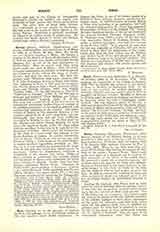

Borrus (BORRI, BURRUS), CHRISTOPHER, missionary, mathematician, and astronomer, b. at Milan in 1583; d. at Rome, May 24, 1632. His family was one of good standing in Milan. He became a member of the Society of Jesus, September 16, 1601; in 1618 he was sent from Macao with Father Petrus Marquez, S.J., as one of the first missionaries to Cochin-China. Here he stayed until 1622, being known under the name of Bruno. After his return he taught mathematics at Coimbra; in 1632 he entered the Cistercian Order, taking the name of Father Onofrio, and died the same year. His most important work “Relatione della nuova missione delli P. P. della Compagnia di Gesi al Regno della Cocincina” appeared at Rome in 1631 and was translated into French (Rennes, 1631), Dutch (Louvain, 1632), Latin and German (Vienna, 1633), and English (London, 1633). It was also inserted in Churchill’s “Collection of Voyages” (1704), II, 787-838, and in Sprengel and Forster’s “Neue Beitrage zur Volkerund Landerkunde” (Leipzig, 1793), II, 27-110. The work was considered one of the best sources of information concerning Cochin-China on account of its excellent description of the physical, political, and ecclesiastical conditions of the country. The observations of Borrus on the magnetic variation of the compass appear to be of more importance, but unfortunately they have not yet been published. According to Kircher he drew up the first chart for the Atlantic and Indian Oceans showing the spots where the magnetic needle makes the same angles with the meridian; in this he is to be regarded as the forerunner of Halley. Borrus gives the explanation to the chart in a manuscript that belongs to the Royal Academy at Lisbon. In another manuscript, now at Evora, “Tratada da arte de navegar pelo Cristovao Bruno”, which bears on the same subject, he makes excellent suggestions, according to Allatius, as to a new method for determining the longitude at sea and also concerning improvements in sea-charts. Father Le Jeunehomme undertook a translation of the treatise into Latin. Philip of Spain, desiring to understand the nautical studies and inventions of Borrus, once summoned the latter from Coimbra to Madrid. Besides what has been already mentioned Borrus wrote, “Doctrina de Tribus Coelis, Aereo, Sydereo et Empeireo” (Lisbon, s. d.), which Pietro de Valle translated into Persian (Mains, Scriptor. vet, nova collect., IV, n. ix), and also some accounts of his travels for the Propaganda.
OTTO HARTIG

